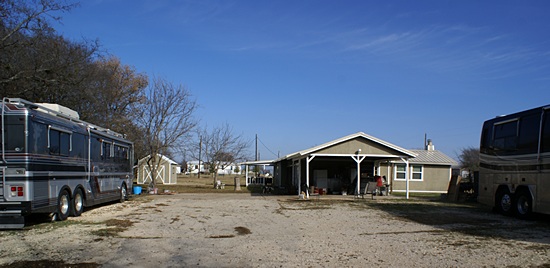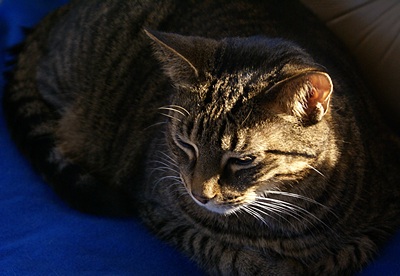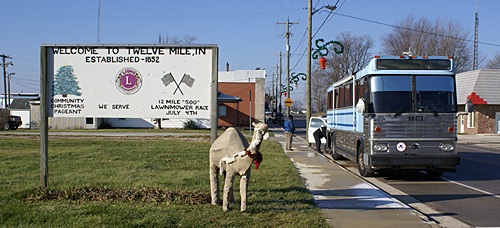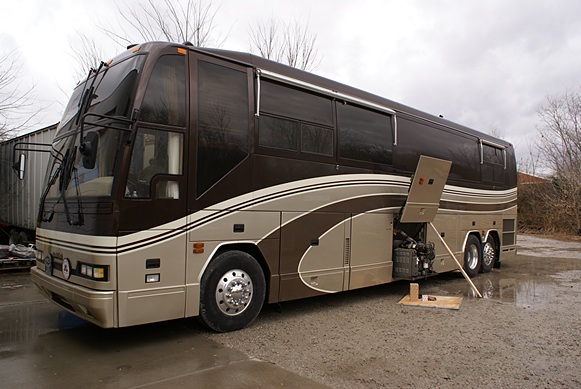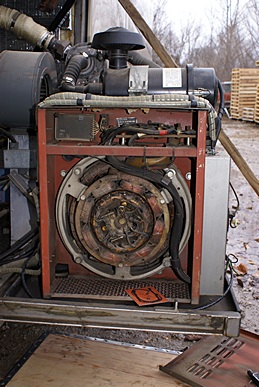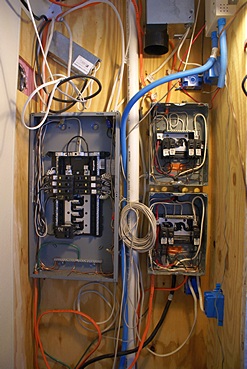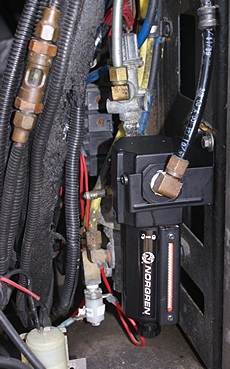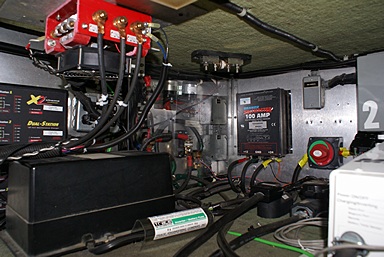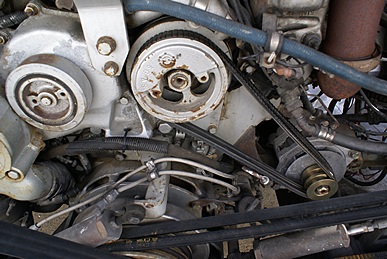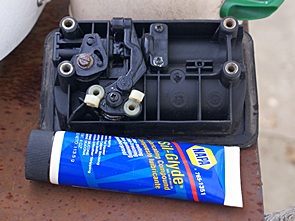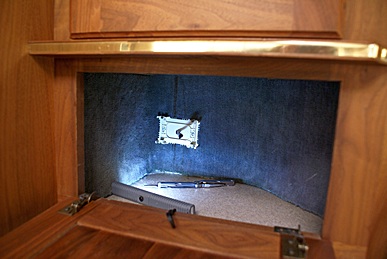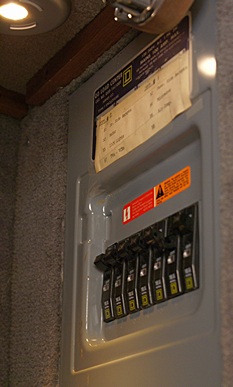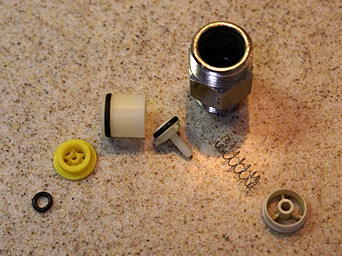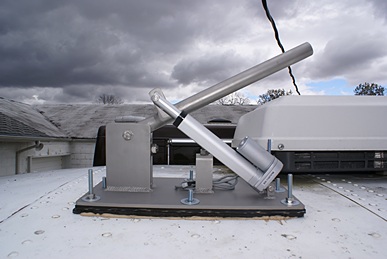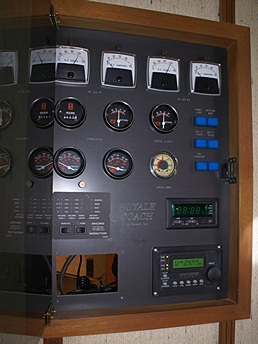2014/12/05 (F) Parting Company (for now)
A set of standing jokes with us involves our answers to the question “what time is it?” The most common response is the day of the week, such as “Friday” (if we know what day it is) or perhaps “I think it’s Friday” (if we are less sure). Variations include “daytime” or “nighttime” both of which only restate the obvious but at least we are usually correct, or perhaps “morning,” “afternoon,” or “evening” if we are trying to be more precise. More globally we might answer “eastern” or “central” referencing the time zone we (think) we are in.
I was awake and ready to get up at 5:30 AM (technically the morning but still dark as night). I checked the house batteries and they were down to 66% SOC (State Of Charge). The coach had been running on the batteries/inverter since 9 PM last night, so 8.5 hours. At 3.6 percentage points per hour I expected a 31 percentage point drop to around 60% SOC, so this charge level seemed reasonable, except that we had very few things running last night. The refrigerator and auxiliary air-compressor were on, of course, although the air-compressor only runs for a few minutes every couple of hours and the fridge runs around 20-24 minutes per hour. The Aqua-Hot was turned on but I did not hear the fans come. I had the thermostats set to 15 (Celsius, 59 Fahrenheit) before we went to bed and the temperature in the coach this morning was in the upper 60s, so I don’t think any of the zone pumps or heat exchanger fans came on overnight. In other words, it seemed to me that we had used more charge from the batteries than we should have. Although I installed the 24 VDC battery bank and the new Magnum inverter/charger two years ago, we have not done very much boondocking (dry camping, no hookups) so we are still figuring out the finer points of this system.
I started the GenSet and the charger came on in bulk charge mode delivering 89 Amps to the battery bank at 29.1 VDC. It switched to absorption mode fairly quickly and by 7:30 AM it was delivering 34 Amps at 28.3 VDC and the SOC was up to 86%. The battery bank has a 400 A-Hr capacity (at “24” VDC, which is actually 25.4 VDC when fully charged) so 10% of that is 40 A-Hr and the generator had returned approximately 80 A-Hrs of charge at 24VDC to the battery bank. (“A-Hr” stands for Ampere-Hours and is actually a measure of energy, specifically electrical charge, which technically should be stated in Coulombs.) “40 A-Hr” means a steady flow of current at a 40 Amp rate for one hour. Note, however, that this also depends on the voltage. 40 A-Hr for a nominal 24 VDC system is twice the energy of 40 A-Hr for a nominal 12 VDC system. Most RVs are set up with a nominal 12 VDC house battery system. Our house battery bank is thus equivalent to an 800 A-Hr, 12 VDC system.)
The downside to all of this is that conventional lead-acid batteries, including our AGM batteries, do not tolerate very well being repeatedly discharged below 50% SOC, so the effective/useable capacity is about 1/2 of the stated capacity. The more deeply the batteries are drained the fewer times they can be brought back up to full charge. Whereas shallow discharging allows for more cycles, and more total energy in and out, but requires a larger battery system to provide power for a reasonable amount of time. Batteries are heavy and bulky, so you cannot just take as many as you would like. For lead-acid batteries 50% discharge seems to be the optimal compromise for battery life, useful run time, and size/weight.
We were up early enough to have a light breakfast and a cup of coffee and have time to digest our meal before we started driving. I powered on our Verizon MiFi and my computer and downloaded e-mails while Linda used her iPad to preview the truck stop options at the interchange just this side of Little a Rock, Arkansas. She also pulled up the satellite image of the Wal-Mart in Texarkana, Texas where we planned to spend the night. Cellular access to the Internet, mapping programs, and satellite imagery, along with GPS receivers have changed the nature of motor vehicle travel in general and RVing in particular. There are certain things where the element of surprise associated with discovery is a good thing, such as an unexpected view when hiking, but when it comes to maneuvering a 40 foot motorcoach with a 20 foot car/towbar attached to its rear end surprises are usually not a good thing.
Around 8 AM we stepped outside and saw Fonda outside with their two dogs (Rascal and Daffy) so we walked back to their bus. Butch was on the phone with U. S. Coach in New Jersey discussing the main engine air-compressor situation. They confirmed that the unloader valve(s) are a common failure point and that the replacement parts were inexpensive and available. He ordered four sets for delivery to Amarillo, Texas where they will be visiting someone while we are in Alvarado, Texas. Two sets are for them and two sets are for us. The parts may not make it to Amarillo until Wednesday, so we will be as flexible in our travel planning as we can. If Donn will let us stay at his place in Alvarado, Texas we may just sit there, unhook the car, and go explore the area.
By 8:30 AM the house battery charger was showing zero (0) Amps at 25.3 VDC, indicating that the batteries were fully charged. The Magnum Battery Monitor Kit (BMK), however, was showing the SOC as 88%. I am inclined to believe that in this case the BMK is not showing the correct SOC, but I will keep a close eye on this. When we get to Donn’s place we will be plugged into a “50 Amp” RV electrical service for at least 40 hours and see what that does to the readings.
While Butch and Fonda had breakfast we went for a stroll around the Wal-Mart parking lot to stretch our legs and scoped out the best egress route. Around 9 AM we started preparing the interior for travel and by 9:45 I had the car prepared for towing and the main engine running. We pulled out at just before 10 AM and took the lead. I drove the first 80 miles at 55 MPH due to light to moderate rain and greatly reduced visibilities. We took exit 161 just east of Little Rock, Arkansas and pulled into a Love’s Truck Stop. Butch picked a better lane than I did and we ended up leaving and driving to the Pilot Truck Stop on the other side of the highway. But before we left Linda walked over to let them know what we were doing and say “so long, see you down the road.” Two miles after we got back on the highway we stayed left for I-430 around the south side of Little Rock while Butch and Fonda stayed on I-40 around the north side of the city. We were headed to I-30 and then southwest towards Dallas while they were headed west towards Amarillo. We will meet up with them next week, perhaps in Midland, Texas or on down the road in New Mexico.
Most of the rest of our drive was through rain but otherwise uneventful. In spite of the weather the drive was very pretty. I-30 west of Little Rock climbs through rolling hills with extensive woodlands on both sides of the highway. We finally drove out from under the rain about 30 miles from Texarkana and finished the trip with bright sun and an ambient temperature of 74 degrees F.
It was easy enough getting off I-30 onto the southbound connector but a bit trickier getting over to make a right turn in the short distance we had. But we did, and turned onto the road that runs in front of the Walmart and down to the far entrance, as planned. I started my left turn into the parking lot road when a guy pulled up to make a left turn coming out of the parking lot. I had tried to swing wide but he realized he needed to back up or risk damage to his truck, so he did. I could not make the first left into the actual parking lot so I went down to the next entrance by the store.
I barely made a 180 degree turn into the first row, causing a women sitting in her car to just stare at us as I missed her by inches (apparently it did not occur to her to back up). I had to straighten out before completing the turn to prevent scraping the driver’s side of the car on a huge boulder at the inside corner of the turn that I somehow did not see before I started the turn but caught sight of in my rearview mirror. Considering that I just completed a drive through less than ideal conditions, which was probably more stressful than I acknowledged, this was not the way I wanted to end our driving for the day. Like with airplanes, however, the takeoffs and landings are usually the trickiest parts.
We pulled into our selected parking spot at the back (east) end of the parking lot, in parallel with several tractor-trailer rigs, at 2:40 PM. I went through our arrival procedure with one glitch; I could not raise or lower the front end of the coach using the Level Low system. It worked fine yesterday so something had obviously changed. I leveled the coach by adjusting the rear tires instead. Once the coach was set I checked the house battery bank SOC. It was 71% but the inverter/charger readout said the battery bank was at 25.0 VDC and the charger was delivering zero (0) Amps. Since no loads were being powered I presumed the voltage was probably a good indication of the battery state. A “12 volt” battery is fully charged at a resting (no load) voltage of 12.6 volts (2.1 volts per cell times six cells). Double that for a “24 volt” battery bank and the full charge resting voltage is 25.2 volts, so our batteries being at 25.0 volts indicated they were probably near full charge.
I decided to wait and turn the generator on later when it was time to cook dinner and let it bring the batteries up to full charge. At this point, however, I am suspicious of the reading I am getting from the Magnum BMK. The data suggests that I do not have the ZENA power generating system tied in to the battery/charger/inverter system in such a way that the BMK can correctly account for the charge the ZENA is providing, but that seems unlikely. Still, I will have to check when we get settled in Quartzsite (or back home in the spring) and/or see if there is a way to reset the 100% SOC level on the BMK. We will be plugged in to a 50 Amp RV service tomorrow at Donn’s so I will see if the SOC rises to that level after being on shorepower for almost 48 hours.
Linda opened a few windows so the cats could have some fresh air. We then walked over to the store for some exercise and fresh air ourselves. I found a case for my Samsung Galaxy S III phone as a tab on my old holder has broken and it no longer holds the phone securely. When we got back a pickup truck towing a 5th wheel trailer had pulled up next to us on the driver’s side. It was parked such that our generator exhaust would blow in their entrance door. I introduced myself to Gary and explained that we would be starting the GenSet in a little while. He appreciated the heads up and elected to back up to where he was clear of our exhaust.
By the time I got back inside Linda was on the phone with Butch. They were at a Wal-Mart in Checotah, Oklahoma just off I-40 about 60 miles west of the Arkansas border. They also ran through rain the rest of the day and it was still raining there when he called. The temporary air-pressure solution had continued to work well all day.
We ran on batteries/inverter until 5:30 PM and then started the generator so Linda could prepare dinner. She needed to cook two baking potatoes in the microwave and sauté some onions, mushrooms, and broccoli using the induction cooker. The microwave kept clicking and I noticed the current drop on that leg each time. The other leg wasn’t drawing much current so I had her keep using the induction cooker and turned on the Aqua-Hot electric heating element. That brought the current draw on each leg roughly into balance and the microwave behaved fine after that. The charger was also drawing a few amps but not the much.
The microwave is wired through the inverter sub-panel. With the generator running, each leg of the AC power is simply passed through the inverter to the sub-panel along with the neutral. I recall that the inverter relays are designed to carry 30 Amps on each leg, but we were only drawing about 20 Amps when the problem occurred so that should not be the source of the problem. It appears that the genset may not tolerate 20 Amps on one leg and zero on the other, or perhaps a differential current draw of 20 Amps. If that’s the case it is either an unfortunate design limitation or an indication that the generator is developing a problem.
In discussing this with Butch he said that gensets wired to produce 240VAC are usually set up to regulated that voltage but the 120VAC from L1 and L2 to Neutral can vary widely. If the voltage on the microwave leg is dropping too low it will cause problems for the unit. It is possible to rewire the genset to produce 120VAC and regulate that voltage, although it might require a new voltage regulator. We would lose the use of our Gaggenau 2-burner cooktop but could live with that limitation. Of more concern to me is the currents from L1 and L2 would now add in the Neutral wire rather than cancel, meaning the current in the Neutral conductor(s) could exceed their design specifications.
I got a TXT message from Chuck inquiring about our trip so I provided a few details. I decided to check the bay under the driver’s seat to see if there was anything obviously wrong with the pneumatic solenoid valves that control the Level Low system. There are red plastic fittings that screw into each solenoid and the fitting on the top one was unscrewed quite a bit. The others were in tight so I screwed the top one back in. I won’t know until tomorrow if that made a difference, but I decided to call Chuck and consult with him as I recalled him mentioning having had problems with these pilot valves on his H3-40.
Chuck did not think the plastic fittings were the problem but offered other salient advice about coils, ‘C’ clips, valves, and rubber ‘O’ rings. If Donn will let us hang around for an extra day I will probably unhook the car and drive to the Prevost service facility near the Dallas Ft. Worth airport and pick up some new solenoid valves and perhaps a couple of Norgren valves and a windshield wiper motor.
We ended up with tractor-trailers pulling in and out around us well into the evening. One in particular parked one spot over from us on the passenger side and let his engine idle for hours. It felt like we were in a truck stop instead of a Wal-Mart parking lot, but given the price we had no basis to complain. Still, if we wanted to stay at a truck stop we would have stayed at a truck stop. Hopefully we can get a decent night’s sleep as I would like to be on the road at sunrise, which is 7:15 AM.
At 8 PM we went for a stroll around the store and the parking lot. Wal-Mart parking lots are well lit as a rule and being 24/7/52 stores, there are always lots of people around making it a comfortable enough environment for an evening walk. As we were getting ready to go to sleep I got a TXT message from Donn, with turn-by-turn directions for getting to his house and a couple of questions, which turned into a short TXT message conversation. While I was texting with Donn our male cat, Jasper, came up by our pillows to look out the window and have a long back-stroking and chin-scratching session with Linda. Traveling is stressful for the cats, especially at first, and they seek the comfort of our attention quite a bit (when they are not sleeping). Squared away on tomorrow’s travel arrangements we drifted off to sleep to the gentle hum (rattle?) of large diesel engines.
2014/12/06 (S) Alvarado, Texas
I was awake at 5 AM and got up shortly thereafter. The house batteries were showing 58% SOC and 24.3 volts with no current draw. I thought about not recharging the batteries and seeing how the ZENA system did on the drive today, but decided I did not want to risk depleting them below 50% SOC. I turned on the generator and the Aqua-Hot electric heating element to balance the load and make hot water for our use this morning. The charger went into Bulk Charging mode putting 88 Amps into the battery bank at 27.4 volts, so the batteries definitely needed recharging after running the coach for 8 hours.
We have and older, 22 cubic foot, residential (AC compressor) refrigerator that I presume accounts for most of the battery use overnight. For each Ampere of current the inverter produces at 120 VAC it would draw 5 Amps from the “24 volt” batteries if it was 100% efficient, which it is not. If I assume the SOC actually dropped from 88% last night at 9 PM (when I shut the generator off) to 58% at 5 AM this morning, the 30 percentage point drop would represent 120 A-Hrs of charge removed from the batteries (30% of 400) which equates to an average continuous draw of 15 Amps per hour at “24” volts. Divide that by 6 (to account for inverter inefficiency) and you get 2.5 Amps per hour at 120 VAC, not that much, really.
It’s a bit more complicated than that, of course, as the refrigerator draws more current when it starts and has an electric heating element around the edge of the doors as well as an automatic defrost feature. Those last two features are nice when connected to shorepower, but are not battery friendly, and I need to rig up a switch that allows me to turn these “features” off when we are dry-camping. We also have an auxiliary air-compressor that supplies pressurized air to operate the toilet and other air-powered accessories. It doesn’t run often but it draws a fair amount of current (at 120 VAC) when it does. We also have small miscellaneous AC and DC loads that are on all the time, but collectively they add up.
By 6:30 AM the charger had shifted to Absorb Mode at 27.9 VDC and was putting 63 Amps into the batteries. Between the charger, the refrigerator, and the electric heating element we were drawing 14 Amps on both legs. I was hoping to be on the road this morning by 7:30 AM. The batteries will not be fully charged by then, so this may be the first real test of the ZENA systems ability to maintain and recharge them while we drive. My ultimate goal is to adjust the ZENA system so it can power the Magnum inverter/charger while we are driving at a level that is sufficient to run the refrigerator and fully, or almost fully, recharge the house battery bank. That will apparently require some tweaking and additional testing which I am not going to do while parked at a Wal-Mart or other dry-camping location.
As we were getting ready to pull out I noted that the batteries were at 83% SOC and shut off the generator. The drive from Texarkana to Alvarado was easy with dry conditions and sunny skies. Traffic was mostly light and we enjoyed the east-central Texas countryside. Traffic got a lot denser as we neared Dallas but once we exited I-30 onto I-635 south it thinned out again. It thickened again as we approached the exit for US-67 south and then thinned out and stayed that way for the rest of the trip to Alvarado. We turned back north on I-35W and pulled in to Donn’s place a few miles north of Alvarado proper around 11:30. I stopped in his driveway, exited the coach, was met by Donn, and we discussed where he wanted me to park.
The desired parking arrangement required us to unhook our car so we did that. With Linda’s assistance I made a four-point turn to get the bus parked. I pulled it up somewhat parallel to Donn’s Bluebird, backed up between the end of a building and a tree, swung forward into the driveway, and then backed around close to, and parallel to, the building. I leveled the coach and this time the front adjustment of the Level Low system worked just fine.
Donn had a 50 Amp RV extension cord available to plug into conveniently located near our utilities bay. By the time I got our coach plugged in it was noon. I checked the meters for the house batteries and they indicated 76% SOC with the charger in Absorb Mode putting 56 Amps into the batteries. For the 4.5 hours we were operating on batteries the expected drop would have been 13.5 to 16.2 percentage points at 3.0 to 3.6 percentage points per hour for a SOC of approximately 70 to 67, so 76 seemed OK, suggesting that the Zena system was doing something.
Linda got things squared away inside the coach and then we sat outside and chatted with Donn for a while. He suggested we get lunch at Spiral, a vegan restaurant in the Ft. Worth medical district. He drove since this is his home turf and he knows his way around. Donn had quesadillas, Linda had a Philly cheesesteak, and I had a patty melt. The food was very, very good.
After lunch Donn took us to Central Market. The Market was not as refined as Whole Foods but had an amazing selection of fresh organic produce and specialty items, such as the tahini Linda needed to make her mock beef stroganoff tomorrow. Our shopping done, Donn took us to meet his friend Jeanine, whose age (85) and health (not the best) prevent her from getting out much. In spite of her issues we had a thoroughly delightful visit, after which we worked our way back to Donn’s place.
Linda checked on the cats and then drew three glasses of Shiner Bock draft beer. Yes, Donn has beer on tap at all times; two taps, actually, but both had Shiner Bock. We sat inside and had a long chat while enjoying our brews. Neither of us had ever heard of bock style beer or the Shiner Company but it was good. Donn was involved in raising mules, building wagons, and participated in a wagon trip around the state of Texas in 1986. At 7 PM Donn started assembling a vegan pasta salad using quinoa pasta, bell pepper, and grape tomatoes. Donn is an excellent cook but was very gracious about accommodating our vegan dietary preferences.
By 8:45 PM we were tired so we said “good night” and returned to our coach for the evening. We read and wrote for a little while. Butch called t let us know they had made it all the way to Amarillo in one day and were safely in the mobile home park where their friend lives. The earliest they will be leaving is Tuesday morning, which may coincide with our travel plans.
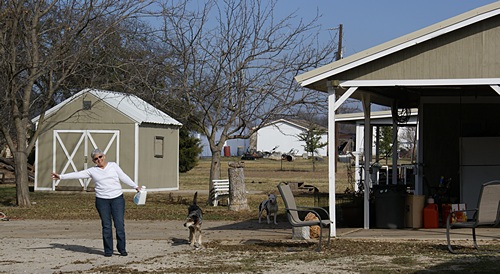
Linda coming back from Donn’s laundry room. Elvis is following her and Lucy is farther back to the right.
2014/12/07 (N) A Day Of Rest
We slept in this morning, which meant I was awake at 6:30 AM, were up/dressed by 7:30, and enjoying our morning coffee (yeah) by 8:00. It was in the mid-40s outside with dense fog, and 62 in the coach; perfect conditions for sleeping but a bit cool for sitting around. The toilet would not flush and I suspected immediately that I had shut the wrong air valve last night. In the excitement of our arrival yesterday, and finally being able to plug in to shore power for the first time since we left Indiana, I had forgotten to switch off the chassis batteries and close the unneeded air valves. I did all of that using a flashlight right before going to bed and once again closed the wrong valve (I have made this mistake before). Opening it this morning fixed the problem, so at least it was an easily corrected operator error and not something that was actually broken and needed to be repaired.
Donn, who is part Comanche, leant us a book by historian T. R. Fehrenback on their history and Linda started reading it this morning. I scanned for WiFi networks with our WiFi Ranger (WFR) and found eight, including two that were “open.” Open networks are not encrypted, so we prefer not to use them, but they may still require a password to gain access. As a general rule we do not “borrow” open WiFi connections from unknown sources. Our Verizon cellular signal here is a very strong 4G/LTE with five bars, but we prefer to use WiFi when available and save our limited cellular data for situations where it’s our only way to get online. I suspected that one of the WiFi signals was Donn’s but could not tell which one it was.
We had oatmeal for breakfast, a nice treat on a cool morning. Linda usually makes oatmeal from scratch these days, but she brought Quaker Instant Raisins, Dates, and Walnuts, which is my favorite. It’s creamy without being mushy, and I just like the way it tastes.
We finally met up with Donn after breakfast and asked him about the available WiFi. He was kind enough to give us the password to his wireless network. He also gave us some Green Tomato Relish he had made and it was spectacular. I mean, this guy can cook. He put on some more coffee and we got back into a long morning discussion on a wide range of topics, so playing with our communications technology had to wait until later.
By 12:30 PM we were all getting hungry and Donn suggested the Mellow Mushroom in the TCU (Texas Christian University?) district of Ft. Worth. We took the long way to get there so we could see the route we would follow when leaving the area and continuing our westward journey on I-20. Our route took us down Camp Bowie Road, past the zoo, and a lovely adjacent neighborhood. While not a vegan restaurant like Spiral, Mellow Mushroom had good vegan pizza options including Daiya non-dairy (non-animal) cheese. We had a thin crust pizza with an olive oil and garlic base, with cheese, mushrooms, onions, and sun-dried tomatoes. Yum.
After lunch we headed back to Alvarado but stopped first at Donn’s next door neighbor’s house so he could get his hair cut. Back at his place we continued our conversation. When it became clear that we were all a bit tired we went back to our coach to give Donn some personal space and downtime. We agreed to meet back in his house between 7:00 and 7:30 PM for dinner. Donn is slightly allergic to cats, so we did not visit or dine in our coach.
With the WiFi network key Donn had provided earlier I was able to connect our WFR to one of the available WiFi signals and upgrade its firmware. I was then able to connect our Amped Wireless Access Point (AWAP) to the WFR, and connect our devices, including the NAS device, to the AWAP. This was our standard setup this past winter in Florida. We used this setup again at the Escapade in May and the GLAMARAMA in June but had not set it up yet on this trip. The advantage of this setup is that the AWAP creates a secure wired/wireless network to which we connect all of our devices and can share data between them. When we cannot connect the WFR to an external WiFi network we turn our Verizon MiFi on and connect the WFR to its WiFi signal instead while all of our devices remain connected to the AWAP. It’s a pretty slick setup that has worked well for us and I was glad it was still working as we appeared to have issues with the WFR while in Twelve Mile, Indiana.
Linda checked online and most of the museums we thought about visiting tomorrow turned out to be closed on Mondays. I was checking e-mail and had a announcement/confirmation for the FMCA National Education Committee worksession tomorrow at 3:00 PM CST. If we do not leave until Wednesday morning we may try to go to a couple museums in Ft. worth on Tuesday while Donn is at work.
A little after 6 PM Linda started preparing her Seitan Mushroom Stroganoff. This is a dish she has made and served at home to our non-vegan friends with great success. Although Donn is a dedicated omnivore, he has other friends who are vegans and has been very thoughtful in the foods he has prepared for us and his selection of restaurants.
Linda used our Gaggenau electric cooktop to cook the dish. She finished it at 7:25 PM and we took it over to the house. We would normally have wine with this dish, but Donn has Shiner Bock beer on tap at the moment and, although I am not a big fan of beer, I found this one to be very much to my taste. It also went well with the dish. We talked for a while after dinner and retired to our coach at 10:45 PM as Donn had to be up early to drive into the office in Dallas.
2014/12/08 (M) Lucy, I’m Home!
Donn left for his office in Dallas long before we got up at 7:30 AM. Granola with fresh bananas, grapefruit juice, and coffee made for a fine breakfast. Donn left us access to the house so we could use the bathroom, which we greatly appreciated. Yes, we have a bathroom onboard, but the less of our stored fresh water we use, and the less we put into our holding tanks, the longer we can go without stopping at a full-hookup RV park. We left home on Sunday, November 30, so this is our 9th day on the road, and we are still above 2/3rds on our fresh-water tank, and probably below 1/3rd on each of our two holding tanks (black- and gray-water). I say “probably” because the level sensors for those two tanks are not very accurate.
We left in our car at 9:30 AM and drove to the Fort Worth Prevost Car Inc. Parts and Service Center just south of the Dallas Fort Worth (DFW) airport in search of some spare parts for our Level Low system and lower windshield wipers. The CatView program on my laptop showed a “641055 Manifold Valve / w/4 Solenoid” on drawing “H4-1640-00 Level-Low – Control Panel & Valves” but I knew I did not want this entire assembly. Art, in the parts department, helped figure out the parts I was looking for, which turned out to be a “641928” for $41.28 and a “641929” for $35.60. One is the solenoid coil and the other is the pneumatic valve, but I’m not sure which is which.
I was also looking for an “800304 Motor Wiper Assembly / 24V / Nidec” as shown on the “H4-2305-05 Lower Windshield Wiper – Installation” drawing. CatView indicated that it had been superseded by “Kit #300506.” That was correct and the cost was $200.03, but they saved me from spending the money as they did not have one in stock. I was also thinking about getting a “641057 Valve, 5 Ways, 3 Positions” (Norgren K41EA00) and a “641056 Valve, 3 Ways, 2 Positions” (Norgren K910058). They were $150.91 and $143.80 respectively so I did not even ask if they were in stock. My diagram also showed a “562353 Diode / 1 Amp” but I decided not to ask about it at this time. I can get most parts delivered in 2 – 3 days via UPS by ordering through their Elgin, Illinois center, but I am trying to stock a set of replacement parts that might be needed for a roadside repair.
Parts in hand we headed back south on TX-360 towards Six Flags to see if we could find the home stadiums of the Dallas Cowboys (AT&T Stadium) and Texas Rangers (Globe Life Park). They were located just west of Six Flags and south of I-30, part of an amazing sports/entertainment complex euphemistically known as “Jerry World” after the owner of the Cowboys.
We got on I-30 westbound, exiting some 14 miles later at Montgomery Street, and followed the signs to the Fort Worth Cultural District. We knew that most of the museums were closed today but we still wanted to see them from the outside. Even if they had been open we did not have time today to go in as I had an FMCA National Education Committee meeting (telephone conference call) at 3 PM CST. We did, however, have time to find Central Market again.
We walked up and down every isle and realized we had seen less than half of the store when we were here on Saturday. Central Market may be the most amazing market we have ever been in. As much as we like Whole Foods, it simply does not rise to the level of Central Market when it comes to fresh/organic items. We picked up some additional fresh and packaged items, including a mix for white bean chili with jalapeños to make for dinner.
When we got back to our coach Linda started the chili. We then took advantage of Donn’s hospitality to do a load of laundry only to discover his dryer was out of commission. No problem; we just hung the laundry outside to dry in the late afternoon Texas sun and let it dry the old fashioned way.
Shortly before 3 PM CST I dialed in to the FMCA National Education Committee meeting and participated in the hour long work session. There were good ideas put forward and it looks like I will have some specific things to do over the next several months.
While the chili cooked we both took a shower, again avoiding using our onboard water and waste tanks. Donn is in the process of getting rid of lots of books and invited us to peruse them and take anything that looked interesting. Linda found a half dozen titles, mostly paperback mysteries, that she will enjoy reading and then leaving in an RV park “library” someone down the road. For never having met prior to noon on Saturday, Donn has treated us like old friends; a most considerate host.
Donn got home from work at 6:15 PM and I let him know that Linda had prepared the chili for dinner. We waited 15 minutes for him to change clothes and tend to his dogs (Elvis and Lucy) and then brought the chili and some crackers to the house. He provided the bowls, spoons, glasses, and draft beer. I don’t think I will give up wine in favor of beer but the Shiner Bock that Donn keeps on draft was easy to drink and very tasty. I detected a subtle hint of sweet citrus in the finish, but no one else did.
Butch called as I was finishing my first bowl of chili. He reminded me that the SKP Dreamcatcher RV park is in Deming, NM just a few miles farther on past Las Cruces, NM and we discussed possibly meeting up there and staying the night. He indicated that he had looked at the unloader valves on their main engine air-compressor and they may not be the problem. Since the parts won’t make it to Amarillo until Wednesday or Thursday they are not going to stick around and planned to head out in the morning. Linda got online to check distances and potential stopping points and found that it was 720 miles from here to Deming, NM and 313 miles to a convenient Wal-Mart in Midland, TX. We let Donn know that we would probably leave in the morning and said our “farewells until next time” and thanked him for his generous hospitality. If our future travels take us anywhere near Dallas Ft. Worth we will definitely stop and spend time with Donn. Heck, we would travel here just to visit with him.
